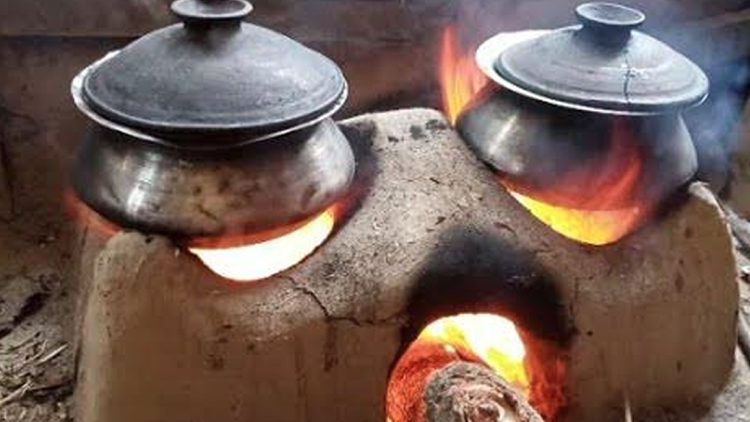| |
| Chalanbeel ancient tradition of clay stoves is disappearing day by day |
| |
| |
 |
| |
| |
| Mirza Abdur Rob Bulbul, Staff Reporter: Chalanbeel is made up of rivers, canals and beels. The historical Chalanbeel of Bangladesh is well known to the people of the whole country as a storehouse of grain and fish. The 9 Upazilas of Chalanbeel are Tarash, Ullapara, Shahjadpur, Faridpur, Bhangura, Chatmohar, Gurudaspur, Singra and Atrai. However, with the evolution of time, with the influence of modernity and the dominance of various types of stoves including gas stoves, electric stoves, rice cookers and microwave ovens, the clay stove, a symbol of the ancient tradition of rural Bengal, is disappearing day by day. From ancient times to the present time, rural women have been making clay stoves with their skilled hands and cooking in them. At one time, clay stoves were the only means of cooking for rural people in every house in the Chalanbeel area. In the current era of electricity and gas stoves, women in cities and villages are turning to gas and magic stoves to avoid the hassle of wood and charcoal fuel. This is why the traditional and traditional clay stoves of rural Bengal are disappearing. This is why the food cooked in clay stoves and the real taste of cooking is disappearing from the market. In the context of the current environmental situation, rural people are joining the machine-dependent era. The traditional clay stove of ancient times will one day emerge from life in the pages of stories, poems, plays and newspapers. The paintings of this art will reach modern civilization in the pages of books. Rural women make this stove with their own hands with clay, so it is called clay stove. At one time, this clay stove was the mainstay of cooking in rural Bengal. In ancient times, people burned wood and straw and burned food in it. In ancient times, people gradually learned the technique of making stoves with clay due to the need to burn food. Since the invention of the first clay stove in the world, history shows that rural women have helped people build clay stoves with hundreds of years of practice. In ancient times, every year, when winter came, women in the entire Chalanbeel area, from the upper class to the lower class, would get busy building clay stoves in their homes. The women of this area would bring clay from the surrounding farmlands and make beautiful stoves. Clay stove makers would make these stoves by arranging lumps of clay one by one. The true beauty of the clay stove gradually emerged with the skillful hands of rural women. In addition, they would enhance the beauty of the clay stove with various types of crafts around the stove. To build a clay stove, a hole was first dug in the ground to make the stove. Three special layers of clay were placed on the hole of the clay stove. Pots and pans were placed on these layers and cooked. Three types of stoves are found in this area: single-faced stoves, double-faced stoves, and triple-faced stoves. These stoves generally have only one opening for fuel entry. Single-faced or double-faced stoves are used for home cooking. Three-faced stoves are used for wedding ceremonies or to boil rice. Single-faced stoves are used for various purposes, including heating food, churning milk, and heating water for tea. These earthen stoves in Chalanbeel use various types of fuel, including bamboo, wood, straw, jute sticks, and dry leaves. The older the kitchen stove, the more reddish it becomes inside. The heat of old earthen stoves is high. After the fire is extinguished after cooking, burning coals and hot ashes remain in the earthen stove. Experienced people believe that these stoves are less prone to accidents and are environmentally friendly. When we went to investigate the information on the spot, many people, on the condition of anonymity, said that the ash of the earthen stove is the main ingredient for cutting fish, the women of the area told this reporter. In addition, the main ingredients of the gas stove are methane, sulfur dioxide, and a little ethane. There is a very small amount of petroleum-based substances. When they come into contact with fire, they burn. And the residue spreads into the environment. At such a time, all the food in the pot also mixes with carbonaceous substances, carbon nanoparticles, and carbon dioxide in small amounts. Due to which the real taste of the food is lost. Methane mixes with water gas in cooking without a lid. Wood is burned in the earthen stove. Which contains cellulose? These are completely burned in the environment, no methane or gaseous substances are emitted. However, the smoke that comes out of the earthen stove is less harmful to the environment. The invention of the earthen stove is one of the most important inventions for mankind. Hundreds of years of practice since the invention of the first stove have helped people make today`s modern stoves. They expressed their strong hope that the government`s support for the demand of the local people`s lives will play a special role in preserving the ancient tradition of clay stoves.
|
| |
|
|
|
| |

|
|
Chief Advisor: Md. Tajul Islam,
Editor & Publisher Fatima Islam Tania and Printed from Bismillah Printing Press,
219, Fakirapul, Dhaka-1000.
Editorial Office: 219, Fakirapul (1st Floor), Dhaka-1000.
Phone: 02-41070996, Mobile: 01720090514, E-mail: [email protected]
|
|
| |
|

